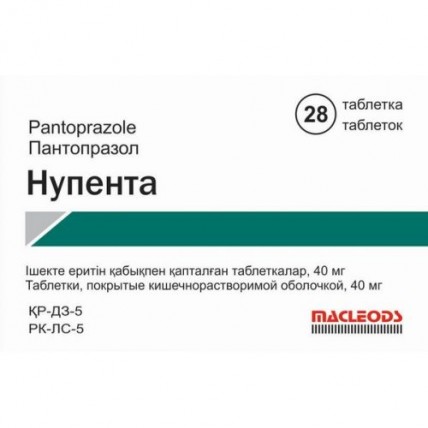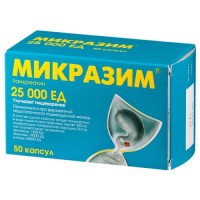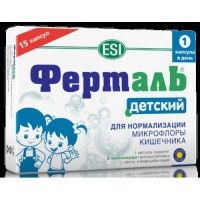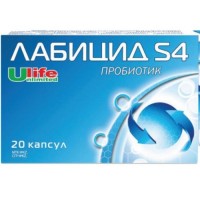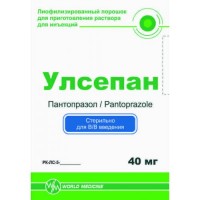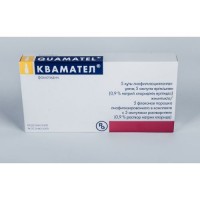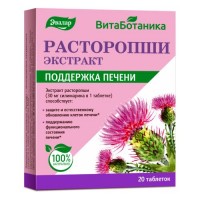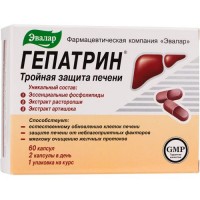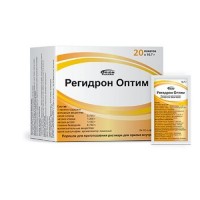Nupenta 28's 40 mg coated tablets
- $19.30
The instruction for medical use of Nupenta Torgovoye medicine Nupent Mezhdunarodnoye's name the unlicensed name Pantoprazol Lekarstvennaya the Tablet form, covered with a kishechnorastvorimy cover, 20 mg and 40 mg One tablet contains Structure: active agent – a pantoprazola of sodium of 42.292 mg (it is equivalent to a pantoprazol of 40.00 mg), a pantoprazola of sodium of 21.146 mg (it is equivalent to a pantoprazol of 20.00 mg), excipients: Mannitolum, krospovidon, sodium a carbonate anhydrous, structure for granulation: sodium a carbonate anhydrous, structure for preliminary greasing: krospovidon, structure for greasing: calcium stearate, structure for a cover covering: gipromelloza, povidone, propylene glycol, titan dioxide (E171), gland (III) oxide yellow (E172), structure of a kishechnorastvorimy cover: methacrylic acid the kopolimer dispersed (Eudragit of L 30 D 55), blackened triethyl citrate, structure: Black Inc Opacode Black S-1-17823. The description of the Tablet of an oval form, with a biconvex surface, covered with a kishechnorastvorimy cover of yellow color (for a dosage of 20 mg). Tablets of an oval form, with a biconvex surface, covered with a kishechnorastvorimy cover of yellow color (for a dosage of 40 mg). Pharmacotherapeutic group Drugs for treatment of the diseases connected with disturbance of acidity. Antiulcerous drugs and drugs for treatment of a gastroesophageal reflux. Inhibitors of the protonew pump. Pantoprazol. The ATX A02BC02 code the Pharmacological Pantoprazol Pharmacokinetics Absorption properties is quickly and completely absorbed after intake. The maximum concentration in plasma is created at single dose of a tablet of a pantoprazol of 40 mg orally. The maximum concentration (Cmax) in blood plasma is reached in 2-4 h (on average, later 2.7 h) after reception of one tablet of a pantoprazol of 40 mg. The pharmacokinetics does not change after single or repeated use. Absolute bioavailability of 70-80% (average 77%). The accompanying meal does not affect bioavailability of a pantoprazol (AUC or Cmax). Distribution the Volume of distribution (Vd) makes about 0.15 l/kg. Linking with proteins of plasma makes about 98%. Very poorly gets through the blood-brain barrier (BBB), cosecretes in breast milk. The pharmacokinetics is linear in the range of doses of 10-80 mg (in proportion to increase in a dose AUC and Cmax increases). Metabolism Pantoprazol is almost completely metabolized in a liver (oxidation, dealkylation, conjugation). Has low affinity to the system of P450 cytochrome. The main metabolism happens by demethylation by means of CYP2C19 to the subsequent connection with sulfate. Other metabolism includes oxidation by means of CYP3A4. The main metabolites - demetilpantoprazol (T1/2 - 1.5 h) and 2 sulphated conjugates. Removal Elimination half-life (T1/2) – 0.9 - 1.9 hour. The clearance is about 0.1 l/h/kg. Because of specific linking of a pantoprazol with the protonew pump of covering cells the elimination half-life is not correlated with increase in time (acid secretion inhibition). The main metabolite of a pantoprazol in serum and urine is dismetilpantoprazol which connects to sulfates. The half-life period of the main metabolite (about 1.5 h) is not much more, than at a pantoprazol. Renal elimination represents the main way of excretion (about 71%), other quantity is brought out of an organism with a stake. Does not kumulirut. The renal failure is not recommended a dose decline of a pantoprazol to patients with renal failures (including patients on dialysis at which only the insignificant quantity of a pantoprazol is removed). Elimination half-life of a pantoprazol is short. Only very small amount of a pantoprazol is exposed to dialysis. Though the main metabolite has longer elimination half-life (2 - 3 hours), discharge occurs quickly, thus, accumulation does not happen. Liver failure For patients with cirrhosis (classes A and B according to classification of Child-Pugh) the value of elimination half-life increased to 7-9 h, and AUC increased by 5 – 7 times, the maximum concentration in blood serum increased in 1.5 in comparison with healthy people. Elderly patients Small increase in AUC and Cmax among elderly patients had no clinical value. Pharmacodynamics action Mechanism Selective inhibitor of the proton pump. Pantoprazol is the substituted benzimidazole inhibiting secretion of hydrochloric acid in a stomach by specific blockade of a proton pomp of covering cells. In acidic environment of covering cells pantoprazol turns into the active form inhibiting enzymes H+, K+-ATFazu at the last production phase of hydrochloric acid in a stomach. Inhibiting effect dozozavisimo also influences basal and stimulated secretion of hydrochloric acid. The maximum effect is shown only in strongly acid (pH 3) Wednesday (at higher values rn remains almost inactive). The therapeutic effect after single dose occurs quickly and remains during 24 h. At most of patients the clinical effect is reached within 2 weeks. As well as at therapy by other inhibitors of a protonew pomp and inhibitors of a receptor H2, treatment pantoprazoly reduces acidity in a stomach and, thus, increases gastrin level in proportion to decrease in acidity. Increase in level of gastrin is a reversible process. As pantoprazol contacts peripheral enzyme in relation to the level of a cellular receptor, it inhibits secretion of hydrochloric acid irrespective of stimulation by other substances (acetylcholine, a histamine, gastrin). At reception of a pantoprazol the gastrin level on an empty stomach increases. At short-term use, in most cases it does not exceed the upper bound of norm. In most cases at long therapy the level of gastrin increases twice. However, excessive increase is observed only in isolated cases. As a result of it, the amount of endocrine cells (ECL) in a stomach in rare instances increases (from insignificant to srednevyrazhenny) at long therapy (from simple to an adenomatoid hyperplasia). Indications Children are more senior than 12 years and adults - treatment of the erosive esophagitis connected with a gastroesophageal reflux disease (GERD) - morbid hyper secretory conditions, including Zollingera-Ellison's syndrome the Route of administration and doses of the Tablet Nupenta are not intended for chewing or crush, it is necessary to swallow of them entirely for an hour before meal, washing down with water. Treatment of the erosive esophagitis connected with a gastroesophageal reflux disease (GERD) of Nupent it is shown at adults and children 12 years for short-term treatment are aged more senior (up to 8 weeks). In case of inefficiency at adult patients, the additional 8 weeks course of a pantoprazol can be considered. Safety of treatment at pediatric patients is not established more than 8 weeks. The recommended doses of a pantoprazol are specified in table 1 Table 1 the Recommended Nupent Pokazaniya's doses the Recommended dose the Frequency (frequency rate) Treatment of the erosive esophagitis connected with a gastroesophageal reflux disease (GERD) adult 40 mg Once a day within 8 weeks * Children of 12 years and Morbid hyper secretory conditions, including Zollingera-Ellison's syndrome adult 40 mg Twice a day ** * in case of inefficiency at adult patients within 8 weeks of treatment are more senior from ≥ than 40 kg 40 mg up to 8 weeks Once a day, the additional 8 weeks course in case of inefficiency at adult patients can be considered. ** The dosage of the scheme has to be corrected taking into account individual needs of the patient. The liver failure to Patients with the profound abnormal liver functions a daily dose of drug should not exceed 20 mg. Side effects the Profile and frequency of adverse reactions for a pantoprazol, the tablets with the slowed-down release observed are reflected in clinical trials of drug in tablets 2 Table 2 the Side reactions reported in clinical trials of adult patients with GERD the Frequency (%) the Headache 12.2 Diarrhea 8.8 Nausea 7.0 Abdominal pain 6.2 Vomiting 4.3 Meteorism 3.9 Dizziness 3.0 Arthralgias 2.8 Side reactions which were registered for a pantoprazol in clinical trials with a frequency ≤ 2% listed below: The general: allergic reaction, pyrexia, reaction of photosensitivity, face edema Digestive tract: a constipation, dryness in a mouth, hepatitis Hematologic: leukopenia, thrombocytopenia Metabolic: increase in a creatine kinase, generalized hypostasis, increase in level of triglycerides, increase in level of liver enzymes Musculoskeletal system: myalgias Nervous system: depression, dizziness Skin and hypodermic cellulose: urticaria, rash, itching Organ of sight: illegibility of sight All side reactions on pantoprazol, observed at adults, are deemed appropriate for pediatric patients. The most often reported (& gt, 4%) side reactions are: headache, fever, diarrhea, vomiting, rash and abdominal pain. Additional side reactions which were registered for a pantoprazol in pediatric group of patients in clinical trials with a frequency ≤ 4% are listed below: The general: allergic reaction, face edema Digestive tract: constipation, meteorism, nausea. Metabolic: increase in level of triglycerides, increase in level of liver enzymes, increase in a creatine kinase Musculoskeletal system: arthralgias, myalgias Nervous system: dizziness, vertigo Skin and hypodermic cellulose: a small tortoiseshell and hypodermic disturbances in fabrics the Following side reactions observed at adults in clinical trials were not observed in pediatric group of patients in clinical trials, but are deemed appropriate and observable and at children: reaction of photosensitivity, dryness in a mouth, hepatitis, thrombocytopenia, generalized hypostasis, a depression, an itching, a leukopenia and illegibility of sight. The side reactions with a frequency of their occurrence observed are listed below, during post-marketing observation it is very frequent (³ 1/10), is frequent (from ³ 1/100 to & lt, 1/10), infrequently (from ³ 1/1000 to & lt, 1/100), is rare (from ³ 1/10000 to & lt, 1/1000), is very rare (& lt, 1/10000), it is unknown (it is impossible to estimate on the available data). Infrequently - sleep disorders - a headache, dizziness - dryness in a mouth, pain and discomfort in a stomach diarrhea, nausea, vomiting, an abdominal distension, a constipation, - increase in level of enzymes of a liver (transaminase, γ-GT) - the rash, a dieback, a skin itching, rash on skin - a fracture of a hip, wrist and backbone - the general weakness, fatigue, fatigue, feeling sick Is rare - an agranulocytosis - hypersensitivity to active and to auxiliary components of drug (including anaphylactic reactions and an acute anaphylaxis) - a lipidemia, increase in level of triglycerides, cholesterol - increase in content of bilirubin - change of weight - flavoring disorders - a depression (and all accompanying complications) - disturbance sight/illegibility of sight - urticaria, a Quincke's disease - arthralgias, myalgias - a gynecomastia - fervescence, peripheral hypostases Very seldom - thrombocytopenia, a leukopenia, a pancytopenia - irritability - loss of orientation in space (and all related complications) Frequency is unknown - a hyponatremia, a hypomagnesiemia - a hypocalcemia, a hypopotassemia - hallucinations, confusion of consciousness (especially at the patients predisposed to these states and also deterioration in these symptoms if they existed prior to treatment) - paresthesias - hepatocellular damages, jaundice, hepatocellular insufficiency - Stephens-Johnson's syndrome, a Lyell's disease, a polymorphic erythema, photosensitivity - a muscular spasm, as a result of disturbances of electrolytic balance - a hamaturia, hypostases, impotence - interstitial nephrite of the Contraindication - hypersensitivity to a pantoprazol and to other components of drug, other substituted benzimidazoles - combined use of a pantoprazol with atazanaviry or nelfinavir - pregnancy and the period of a lactation - - intolerance of fructose Medicinal interactions Antiretroviral drugs it is not recommended to use children's age up to 12 years atazanavir or nelfinavir with inhibitors of a protonew pomp. It is expected that joint introduction of an atazanavir or nelfinavir with inhibitors of a protonew pomp will significantly reduce concentration of an atazanavir or a nelfinavir in plasma and can lead to loss of therapeutic effect and development of drug resistance. Coumarinic anticoagulants (warfarin) At combined use of warfarin with inhibitors of a protonew pomp, several isolated cases of change of the International normalized relation were celebrated (MNO or INR). Therefore for the patients undergoing treatment by coumarinic anticoagulants (for example, warfarin), it is recommended to watch a prothrombin time / MNO after the beginning, the termination or during irregular use of a pantoprazol. Klopidogrel Soputstvuyushchee purpose of a pantoprazol and klopidogrelya at healthy faces had no clinically significant effect at influence of an active metabolite klopidogrelya or klopidogrelingirovanny inhibition of thrombocytes. Correction of a dose of a klopidogrel is not required at introduction with the approved dose of a pantoprazol. Drugs for which rn a stomach Pantoprazol can affect bioavailability are caused by long inhibition of secretion of acid in a stomach. Thus, pantoprazol can interfere with absorption of drugs where rn a stomach is an important determinant of their bioavailability (for example, ketokonazol, ethers of ampicillin and salt of iron). False positive analyses of urine on TGC (tetrahydrocannabinol) It was reported about false positive tests for screening of urine for tetrahydrocannabinol (TGC) at the patients receiving inhibitors of a protonew pomp. The alternative confirming method should be considered for check of positive takes. The methotrexate leads Simultaneous use of high doses of a methotrexate and inhibitors of a protonew pomp to increase in level of a methotrexate and/or its metabolite of the hydroksimetotriksat at some patients. However, no official researches of interaction of drug of a methotrexate with inhibitors of a protonew pomp were conducted Intolerance of fructose Patients with rare inherited disorders and intolerance of fructose should not accept Nupenta. Special instructions the Simultaneous malignant new growth of a stomach the Symptomatic response to therapy pantoprazoly does not exclude existence of a malignant new growth of a stomach. In this connection, before an initiation of treatment it is necessary to exclude a possibility of a malignant new growth. Atrophic gastritis Atrophic gastritis was sometimes noted at a biopsy at patients, is long receiving pantoprazol. The deficiency of cyanocobalamine (B12 vitamin) At the patients suffering from Zollingera-Ellison's syndrome and other pathological hyper secretory diseases demanding long-term treatment, pantoprazol as well as all medicines blocking acids can reduce absorption of B12 vitamin (cyanocobalamine) in connection with hypo - or an achlorhydria. It has to be considered at patients with a reduced stock or with risk factors of reduced absorption of B12 vitamin at long therapy or in the presence of the corresponding clinical symptoms. The diarrhea caused by Clostridium difficile the Published results of observation researches show that therapy by inhibitors of a protonew pomp (pantoprazoly), can be connected with the increased risk of the diarrhea caused by Clostridium difficile, especially in the hospitalized patients. This diagnosis should be considered in diarrhea which does not improve. Patients have to use the lowest dose and the shortest duration of therapy by inhibitors of a protonew pomp corresponding to a state which treat. The bone fracture of Several published observation researches is shown that therapy by inhibitors of the proton pump (IPP) can moderately increase risk of a fracture of femur, wrist or backbone, connected with osteoporosis, especially at people of old age or with other risk factors. The risk of a change was increased at the patients receiving high doses of drug or long therapy. Patients have to use the lowest dose and the shortest duration of therapy of IPP corresponding
to an ostoyaniye which treat. The hypomagnesiemia the Severe form of a hypomagnesiemia meets at the patients receiving treatment by inhibitors of a protonew pomp for at least three months. Serious manifestations of a hypomagnesiemia, such as fatigue, a tetany, mental disorders with manifestations of excitement, spasms, dizzinesses, ventricular arrhythmia, can also occur in connection with medicine use, but they can proceed imperceptibly and, as a result, can be not diagnosed. At most of patients the hypomagnesiemia improves after replacement therapy by magnesium and the terminations of intake of inhibitors of a protonew pomp. The recommendations of the attending physician about measurement of level of magnesium prior to use of inhibitors of a protonew pomp are necessary for patients to whom long-term treatment is recommended or who accept inhibitors of a protonew pomp together with the digoxin or medicines capable to cause a hypomagnesiemia (for example, diuretic means) and also during treatment. The liver failure of the Dose is higher than 40 mg/days not was are studied at patients with abnormal liver functions. At the patients having a heavy liver failure during treatment by Nupenta, in particular at long therapy, it is necessary to carry out monitoring of level of liver enzymes periodically. In case of increase in level of liver enzymes, treatment should be interrupted. Use for Nupent's children it is not recommended to the children who did not reach 12-year age because of a lack of data on safety and efficiency for use. A system lupus erythematosus Use of inhibitors of a proton pomp, seldom or never connect with development of a subacute skin form of the system lupus erythematosus (SLE). These changes happen more often under the influence of sunshine on open sites of skin and if they are followed by a joint pain, the patient has to see in due time the attending physician for the solution of a question of need of drug withdrawal. At the patients having such reactions in the anamnesis the risk of development of hard currency at use of other inhibitors of a proton pomp is increased. Existence of disturbing symptoms in case of development of disturbing symptoms (for example, considerable loss of body weight, periodic vomiting, dysphagias, a hematemesis, anemia or a melena) or suspicion/presence of stomach ulcer, it is necessary to exclude malignant process as treatment by Nupenta can weaken symptoms and lead to overdue diagnostics. If symptoms remain, despite of the carried-out appropriate treatment, it is necessary to conduct additional researches. Elderly patients of Pokazateli of side reactions and laboratory disturbances at patients at the age of 65 years are also more senior resembled those which are connected with patients more young than 65 years. Dose adjustment is not required to elderly patients. Paul Pokazateli incidences of side reactions were identical to men and women. It is not recommended to Nupent to apply pregnancy during pregnancy if only such reception is not obvious need. The period of a lactation of the Research was shown about discharge of a pantoprazol in breast milk at women. Thus, it is not recommended to Nupent to apply during feeding by a breast. The feature of influence of medicine on ability to run the vehicle or potentially dangerous mechanisms Should refrain from control of the vehicles and other mechanisms requiring special attention because of the probability of dizzinesses and a disorder of vision. As as a part of drug Mannitolum contains, can cause moderate aperient action. Overdose Symptoms: strengthening of severity of side effects Treatment: drug withdrawal. Specific antidote does not exist. Symptomatic therapy. Drug is not removed by means of a hemodialysis. Forms of release and packing On 7 tablets place in blister strip packaging from aluminum foil (Alu/Alu). On the 4th blister strip packagings together with the instruction for medical use in the state and Russian languages place in a pack from cardboard. To Store storage conditions in the dry, protected from light place at a temperature not over 25 ºС to Store out of children's reach! 2 years not to apply a period of storage after an expiration date. Prescription status According to the prescription the Name and the country of the Macleods Pharmaceuticals Limited 304, Atlanta Arcade, Marol Church Road, Andheri (East), Mumbai manufacturing organization – 400,059, India. The holder of the registration certificate of Macleods Pharmaceuticals Limited, India the Name and the country of the organization of the packer of Macleods Pharmaceuticals Limited, India the Address of the organization accepting in the territory of the Republic of Kazakhstan claims from consumers on quality of products and responsible for post-registration observation of safety of medicine in the territory of the Republic of Kazakhstan Branch KOO "Macleods Pharmaceuticals Limited", Republic of Kazakhstan Almaty, Tulebayev St. 38/61, 5 the floor the Ph./fax. +7 727 2734593, 8 7011100343 E-mail: danielt@macleodspharma.com.
To develop
to an ostoyaniye which treat. The hypomagnesiemia the Severe form of a hypomagnesiemia meets at the patients receiving treatment by inhibitors of a protonew pomp for at least three months. Serious manifestations of a hypomagnesiemia, such as fatigue, a tetany, mental disorders with manifestations of excitement, spasms, dizzinesses, ventricular arrhythmia, can also occur in connection with medicine use, but they can proceed imperceptibly and, as a result, can be not diagnosed. At most of patients the hypomagnesiemia improves after replacement therapy by magnesium and the terminations of intake of inhibitors of a protonew pomp. The recommendations of the attending physician about measurement of level of magnesium prior to use of inhibitors of a protonew pomp are necessary for patients to whom long-term treatment is recommended or who accept inhibitors of a protonew pomp together with the digoxin or medicines capable to cause a hypomagnesiemia (for example, diuretic means) and also during treatment. The liver failure of the Dose is higher than 40 mg/days not was are studied at patients with abnormal liver functions. At the patients having a heavy liver failure during treatment by Nupenta, in particular at long therapy, it is necessary to carry out monitoring of level of liver enzymes periodically. In case of increase in level of liver enzymes, treatment should be interrupted. Use for Nupent's children it is not recommended to the children who did not reach 12-year age because of a lack of data on safety and efficiency for use. A system lupus erythematosus Use of inhibitors of a proton pomp, seldom or never connect with development of a subacute skin form of the system lupus erythematosus (SLE). These changes happen more often under the influence of sunshine on open sites of skin and if they are followed by a joint pain, the patient has to see in due time the attending physician for the solution of a question of need of drug withdrawal. At the patients having such reactions in the anamnesis the risk of development of hard currency at use of other inhibitors of a proton pomp is increased. Existence of disturbing symptoms in case of development of disturbing symptoms (for example, considerable loss of body weight, periodic vomiting, dysphagias, a hematemesis, anemia or a melena) or suspicion/presence of stomach ulcer, it is necessary to exclude malignant process as treatment by Nupenta can weaken symptoms and lead to overdue diagnostics. If symptoms remain, despite of the carried-out appropriate treatment, it is necessary to conduct additional researches. Elderly patients of Pokazateli of side reactions and laboratory disturbances at patients at the age of 65 years are also more senior resembled those which are connected with patients more young than 65 years. Dose adjustment is not required to elderly patients. Paul Pokazateli incidences of side reactions were identical to men and women. It is not recommended to Nupent to apply pregnancy during pregnancy if only such reception is not obvious need. The period of a lactation of the Research was shown about discharge of a pantoprazol in breast milk at women. Thus, it is not recommended to Nupent to apply during feeding by a breast. The feature of influence of medicine on ability to run the vehicle or potentially dangerous mechanisms Should refrain from control of the vehicles and other mechanisms requiring special attention because of the probability of dizzinesses and a disorder of vision. As as a part of drug Mannitolum contains, can cause moderate aperient action. Overdose Symptoms: strengthening of severity of side effects Treatment: drug withdrawal. Specific antidote does not exist. Symptomatic therapy. Drug is not removed by means of a hemodialysis. Forms of release and packing On 7 tablets place in blister strip packaging from aluminum foil (Alu/Alu). On the 4th blister strip packagings together with the instruction for medical use in the state and Russian languages place in a pack from cardboard. To Store storage conditions in the dry, protected from light place at a temperature not over 25 ºС to Store out of children's reach! 2 years not to apply a period of storage after an expiration date. Prescription status According to the prescription the Name and the country of the Macleods Pharmaceuticals Limited 304, Atlanta Arcade, Marol Church Road, Andheri (East), Mumbai manufacturing organization – 400,059, India. The holder of the registration certificate of Macleods Pharmaceuticals Limited, India the Name and the country of the organization of the packer of Macleods Pharmaceuticals Limited, India the Address of the organization accepting in the territory of the Republic of Kazakhstan claims from consumers on quality of products and responsible for post-registration observation of safety of medicine in the territory of the Republic of Kazakhstan Branch KOO "Macleods Pharmaceuticals Limited", Republic of Kazakhstan Almaty, Tulebayev St. 38/61, 5 the floor the Ph./fax. +7 727 2734593, 8 7011100343 E-mail: danielt@macleodspharma.com.
To develop
